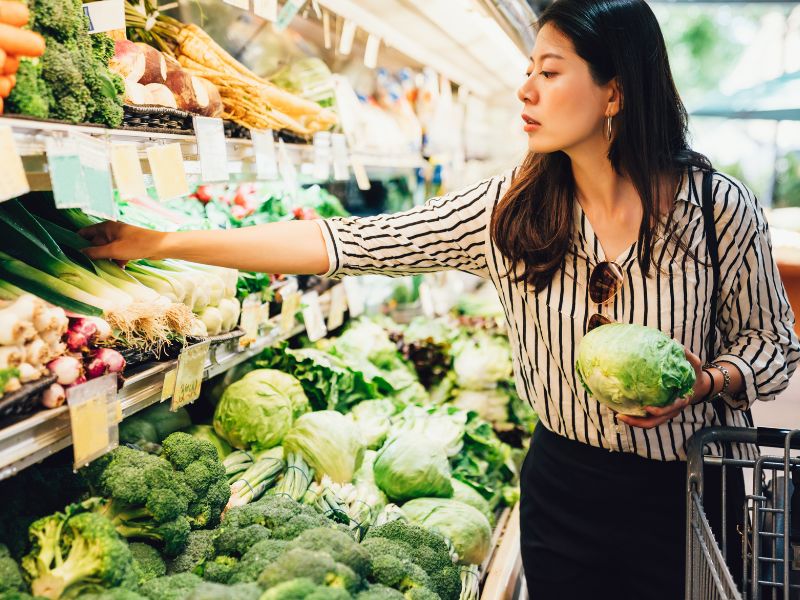7 Techniques to Shop Smart and Generate Less Waste in your Kitchen

In the United States, food waste is estimated at between 30-40 percent of the food supply which equals approximately 133 billion pounds and $161 billion worth of food Food is the largest single source of waste in the U.S. More food ends up in landfills than plastic or paper. According to the U.S. Environmental Protection Agency, 20 percent of what goes into municipal landfills is food.
We think of food waste as something that happens at home. In reality, it starts with what we put in our grocery carts. With grocery stores designed to tempt us in every aisle, it’s easy to end up overbuying. Smart shopping is one of the quickest ways to prevent food waste while also saving money. This means fine-tuning your grocery shopping habits so everything you buy gets put to good use. The two main aspects of smart shopping are planning and being realistic.
Planning
Proper planning is critical to waste prevention. Research has shown that most of us do not check our fridge or pantries before heading off to the grocery store, which results in duplicate items being purchased. Always check your supply at home first and bring a list to the grocery store. As obvious as this may sound, many people don’t bother with shopping lists, and this can make a big impact on preventing us from buying duplicate items or purchasing things we might not actually want or need.
One step further, the optimal strategy is to pre-plan meals for the week, develop the list of ingredients and exact quantities needed, review your pantry and fridge for what you might already have, and then head out to the store. Don’t forget to take leftovers and nights off into account in your plan.
Incorporate strategies that work for you
But making a 7-day meal plan may not be realistic for all of us, so just as important as planning is understanding our habits and lifestyle and having your plans reflect reality. Do not be over-ambitious in your meal planning for the week; buying more ingredients in the hopes it will persuade you to cook is not a great method and more often wastes a lot of food and money. Be realistic about what will work for you and your family! Adjust your planning for the days you will get takeout because you don’t feel like cooking or life gets too busy.
Here are 7 tips to help you buy just what you need.
- Think about how many meals you’ll eat at home this week and how long before your next shopping trip. Before you leave for the market, shop your kitchen first and note items you already have so you don’t end up with duplicates.
- Make a list and stick to it. By shopping from a list you are much less likely to buy things you don’t need and won’t eat.
- Shop more frequently. Purchase only what you need for the next few meals. Generally, it is not very easy to predict what we want to eat in the future, so we tend to overbuy and waste food.
- Buy fresh items in smaller quantities. Choose loose fruits and vegetables rather than larger amounts that often come in packages, boxes or in plastic bags.
- Shop on a full stomach to help you reduce impulse buys.
- Don’t fall for marketing techniques to get you to spend more money, like buying in bulk or ‘2 for 1’ items, unless you are sure you will use all of it.
- Shop at farmer’s markets where you will usually find fresher food that will last longer and is grown locally (which also reduces the food’s carbon footprint).
Check out our guide on prepping and storing food to continue best practices once you’re back from the store. If you are following good storage practices but you still end up wasting a lot of raw ingredients, smart shopping might be the area you need to focus on!
Waste reduction has far-reaching impacts on society:
- Food that could have helped feed people in need is sent to landfills.
- Food waste that decomposes in landfills releases methane, a greenhouse gas that is at least 28 times more potent than carbon dioxide.
- Land, water, labor, energy, and other inputs are used and thus wasted in producing, processing, transporting, preparing, storing, and disposing of discarded food.
With the waste you do end up with, we hope you will compost it instead of sending this waste to the landfill. Spoiled and leftover food is perfect for composting often providing the “green” nutrients needed to form a balanced compost pile.
Further Resources
- Meal planning guides – Natural Resource Defense Council (NRDC)
- Shopping Guidelines – Natural Resource Defense Council (NRDC)
- Shop with meals in mind – example shopping list from the EPA
- Guestimator – NRDC’s calculator for making the right amount of food for your guests
Article was written with assistance by Solana Center Docent David.
